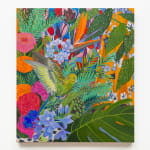





Anna Valdez
Further images
In the context of Valdez’s works, the socio-political history of a cabinet of curiosities, also known as Wunderkammer, can been traced back to the Renaissance period in Europe. These collections, often assembled by aristocrats, scholars, and explorers, were encyclopaedic in nature, encompassing a wide range of natural specimens, scientific instruments, artistic objects, and cultural artefacts. Cabinets of curiosities were considered microcosms of the world, representing the collector’s knowledge, wealth, and social status. They served as symbols of power, prestige, and intellectual curiosity, reflecting on the worldview of their owners.
Often depicted in Valdez’s works, the notion of a cabinet of curiosities holds significant meaning. By incorporating taxidermy birds, animal bones, feathers, shells, highly decorative patterns, and a maximalist approach, she invokes the sense of wonder and curiosity that defined these cabinets. Her paintings serve as contemporary versions of the cabinets, presenting viewers with a visual feast of carefully chosen objects and arrangements.
Valdez’s recent paintings such as, Green Parakeet with Birds of Paradise Flower, 2024 and Two Parakeets with Coral, 2023, depicts taxidermy birds as avatars for the human figures, imbuing them with symbolism and cultural references. In this way, she bridges the natural world with the rich tapestry of art history, encouraging viewers to contemplate the interconnectedness of life and the depths of human experience.






